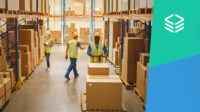It’s been an incredible year in ecommerce. Growth has been rapid, and with the pandemic as an accelerant, U.S. ecommerce market will hit levels this year that experts didn’t expect until 2023. Beyond facts and figures, who would have ever expected supply chain challenges to be front page consumer news? The industry is changing rapidly, and Flowspace is excited to shape the future. Ahead of 2022, I’m making four predictions about ecommerce in the year ahead.
1. Retail drives investment in digital supply chain tech
In 2022, we will see widespread adoption of cloud-based commerce technologies that enable retailers to shore up supply chains. As current challenges illustrate, the infrastructure supporting supply chains is not built for an ecommerce-driven future. Functions are siloed, and optimized for a B2B world where ten thousand units of a product are delivered to one big box store, not ten thousand individual front doors.
Supply chain tech investment has exceeded $7B for the last three quarters, flowing to companies building the digital infrastructure that supports and connects disparate functions – from shipping and drayage to storage, fulfillment, and last-mile delivery – providing end-to-end visibility, and the data and insights needed to optimize operations. The trend will continue, as more brands join retailers like Albertson’s, The Home Depot, and Walmart in building their tech stacks to support ecommerce.
2. Consumers increase spend with independent brands that align with their values
The pandemic altered shopping behaviors beyond simply pushing people online. While many consumers made the bulk of their purchases through platforms like Amazon that have a wide variety of product options, others chose to shop more frequently with local and small businesses, prioritizing quality, customer service, and sustainability in support of independent business owners and sellers. As the retail giants (and their carbon footprints) grow, anticipate even more consumer pushback.
Thanks to the increased availability and reliability of independent fulfillment networks, these businesses and brands are able to offer fast, affordable shipping on par with Amazon Prime, without being reliant on FBA. Brands get the added benefit of custom branded packaging options, and the ability to maintain customer data, which allows them to provide the personalized experiences customers prefer.
3. DTC success leads to retail availability for more brands
DTC-native brands, once lauded for their ability to cut out the retail middleman, now face rising marketing costs amidst increased competition online. Disruptive brands in 2022 are omnichannel – offering product availability and a seamless customer experience, no matter where or how a customer is shopping – and the leap to retail store availability is a marker of success for most.
Tree-free paper company Reel Paper is an example of this move from DTC to retail. The company started as an online-only subscription service and saw growth surge during the great toilet paper shortage of 2020. As demand continued to increase, Reel was invited to distribute into Target retail stores, where it is now available from coast to coast in addition to the brand’s digital storefront.
Reel is also implementing innovative fulfillment and delivery strategies; understanding that the speed of commerce is constantly increasing, the brand is offering same-day delivery where available, meeting rising customer demand for speed and convenience.
4. Privacy drives advertisers into ecommerce
Amidst heightened privacy concerns, ongoing changes restricting how users are tracked online are causing digital ad prices to rise and consumer acquisition costs to skyrocket. Advertisers are looking to capture audiences in new ways – including on social platforms, where ecommerce is becoming entertainment with the emergence of new live shopping experiences on platforms like TikTok and Twitter.
eMarketer says that 36 percent of social media users will make a purchase via social commerce this year, and the commercialization of social media is predicted to reach $80B in the US by 2025. With so much money up for grabs, expect the social platforms to take a cut as they implement the infrastructure necessary to support in-app ecommerce.
![]()





